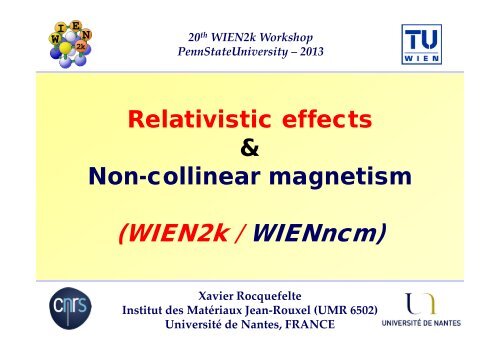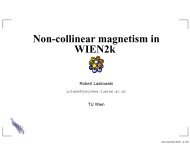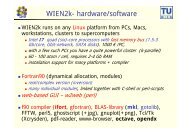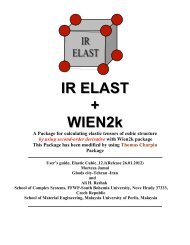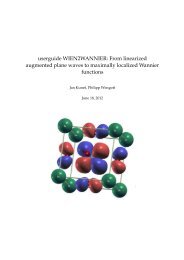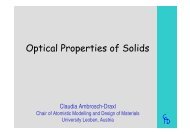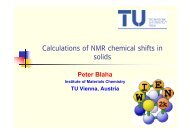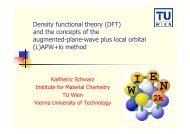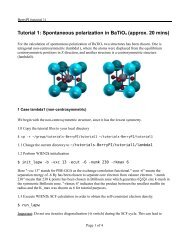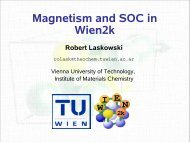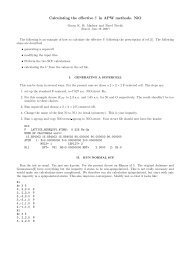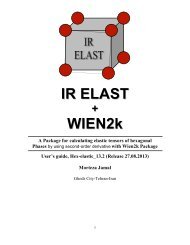Relativistic effects, spin-orbit coupling and non-collinear ... - WIEN 2k
Relativistic effects, spin-orbit coupling and non-collinear ... - WIEN 2k
Relativistic effects, spin-orbit coupling and non-collinear ... - WIEN 2k
Create successful ePaper yourself
Turn your PDF publications into a flip-book with our unique Google optimized e-Paper software.
20 th <strong>WIEN</strong><strong>2k</strong> WorkshopPennStateUniversity – 2013<strong>Relativistic</strong> <strong>effects</strong>&Non-<strong>collinear</strong> magnetism(<strong>WIEN</strong><strong>2k</strong> / <strong>WIEN</strong>ncm)Xavier RocquefelteInstitut des Matériaux Jean‐Rouxel (UMR 6502)Université de Nantes, FRANCE
20 th <strong>WIEN</strong><strong>2k</strong> WorkshopPennStateUniversity – 2013Talk constructed using the following documents:Slides of:Robert Laskowski, Stefaan Cottenier, Peter Blaha <strong>and</strong> Georg MadsenNotes of:- Pavel Novak (Calculation of <strong>spin</strong>-<strong>orbit</strong> <strong>coupling</strong>)http://www.wien<strong>2k</strong>.at/reg_user/textbooks/- Robert Laskowski (Non-<strong>collinear</strong> magnetic version of <strong>WIEN</strong><strong>2k</strong> package)Books:- <strong>WIEN</strong><strong>2k</strong> userguide, ISBN 3-9501031-1-2- Electronic Structure: Basic Theory <strong>and</strong> Practical Methods, Richard M. MartinISBN 0 521 78285 6- <strong>Relativistic</strong> Electronic Structure Theory. Part 1. Fundamentals, PeterSchewerdtfeger, ISBN 0 444 51249 7web:- http://www2.slac.stanford.edu/vvc/theory/relativity.html- wienlist digest - http://www.wien<strong>2k</strong>.at/reg_user/index.html- wikipedia …
Few words about Special Theory of RelativityLightComposed of photons (no mass)Speed of light = constantAtomic units:ħ = m e = e = 1c 137 au
Few words about Special Theory of RelativityLightComposed of photons (no mass)Speed of light = constantMatterComposed of atoms (mass)v = f(mass)Atomic units:ħ = m e = e = 1Speed ofmattermassc 137 aumass = f(v)
Few words about Special Theory of RelativityLightComposed of photons (no mass)Speed of light = constantMatterComposed of atoms (mass)v = f(mass)Atomic units:ħ = m e = e = 1Speed ofmattermassc 137 aumass = f(v)Lorentz Factor (measure of the relativistic <strong>effects</strong>) 11vc2 1<strong>Relativistic</strong> mass: M = m (m: rest mass)Momentum: p = mv = MvTotal energy: E 2 = p 2 c 2 + m 2 c 4E = mc 2 = Mc 2
Definition of a relativistic particle (Bohr model)10987654321Lorentz factor ()« Non-relativistic »particle: = 1H(1s)Au(1s)0 20 40 60 80 100 120Speed (v)Details for Au atom:79v e( 1s) c 0. 58c137c 137 au 11v ecSpeed of the 1s electron (Bohr model):Zv en211s electron of Au atom = relativistic particlee -10.582+Ze: v e (1s)1au H : v 1. 00003e (1s) 1au 1. 00003Au : vAu : ve (1s) 79 au e (1s) 1.2279 au 1.221.22M e (1s-Au) = 1.22m e
<strong>Relativistic</strong> <strong>effects</strong>+Ze1) The mass-velocity correction<strong>Relativistic</strong> increase in the mass of an electron with its velocity (when v e c)
<strong>Relativistic</strong> <strong>effects</strong>+Ze1) The mass-velocity correction<strong>Relativistic</strong> increase in the mass of an electron with its velocity (when v e c)2) The Darwin termIt has no classical relativistic analogueDue to small <strong>and</strong> irregular motions of an electron about its mean position (Zitterbewegung*)*AnalysisofErwinSchrödingerofthewavepacketsolutionsoftheDiracequationforrelativisticelectrons in free space:The interference between positive <strong>and</strong> negative energy states produces whatappears to be a fluctuation (at the speed of light) of the position of an electron around the median.
<strong>Relativistic</strong> <strong>effects</strong>+Ze1) The mass-velocity correction<strong>Relativistic</strong> increase in the mass of an electron with its velocity (when v e c)2) The Darwin termIt has no classical relativistic analogueDue to small <strong>and</strong> irregular motions of an electron about its mean position (Zitterbewegung)3) The <strong>spin</strong>-<strong>orbit</strong> <strong>coupling</strong>It is the interaction of the <strong>spin</strong> magnetic moment (s) of an electron with the magnetic fieldinduced by its own <strong>orbit</strong>al motion (l)
<strong>Relativistic</strong> <strong>effects</strong>+Z eff e1) The mass-velocity correction<strong>Relativistic</strong> increase in the mass of an electron with its velocity (when v e c)2) The Darwin termIt has no classical relativistic analogueDue to small <strong>and</strong> irregular motions of an electron about its mean position (Zitterbewegung)3) The <strong>spin</strong>-<strong>orbit</strong> <strong>coupling</strong>It is the interaction of the <strong>spin</strong> magnetic moment (s) of an electron with the magnetic fieldinduced by its own <strong>orbit</strong>al motion (l)4) Indirect relativistic effectThe change of the electrostatic potential induced by relativity is an indirect effect of thecore electrons on the valence electrons
One electron radial Schrödinger equationHARTREE ATOMIC UNITSINTERNATIONAL UNITS 1 2H S2V HS22me2V Atomic units:ħ = m e = e = 11/(4 0 ) = 1c = 1/ 137 au
One electron radial Schrödinger equationHARTREE ATOMIC UNITSINTERNATIONAL UNITS 1 2H S2V V ZrHIn a sphericallysymmetric potential RSrY,n, l,m n,l l,mV22me22Ze 4 rV 022 1 2 1 1 r sin 222 22r r r r sin r sin Atomic units:ħ = m e = e = 11/(4 0 ) = 1c = 1/ 137 au
One electron radial Schrödinger equationHARTREE ATOMIC UNITSINTERNATIONAL UNITS 1 2H S2V V ZrHIn a sphericallysymmetric potential RSrY,n, l,m n,l l,mV22me22Ze 4 rV 022 1 2 1 1 r sin 222 22r r r r sin r sin 12r2ddrr2dRdrn,l Vl l 122rRn,l Rn,l22me12rddrr2dRdrn,l V22mel l 12rRn,l Rn,l
Dirac Hamiltonian: a brief descriptionDirac relativistic Hamiltonian provides a quantum mechanical descriptionof electrons, consistent with the theory of special relativity.E 2 = p 2 c 2 + m 2 c 4H D withHDc p m ce2V
Dirac Hamiltonian: a brief descriptionDirac relativistic Hamiltonian provides a quantum mechanical descriptionof electrons, consistent with the theory of special relativity.E 2 = p 2 c 2 + m 2 c 4H D withHDMomentumoperator c p m ceRest mass2VElectrostaticpotentialk 0k0k k100 1(22) unit <strong>and</strong>zero matrices1011020 i i0 3100 1(22) Pauli <strong>spin</strong> matrices
Dirac equation: H D <strong>and</strong> are 4-dimensional is a four-component single-particle wave function that describes <strong>spin</strong>-1/2particles.<strong>spin</strong> up<strong>spin</strong> downH D1 1 2 2 33 4 4 In case of electrons:Largecomponents ()Smallcomponents () factor 1/(m e c 2 ) <strong>and</strong> are time-independent two-component <strong>spin</strong>ors describing the spatial<strong>and</strong> <strong>spin</strong>-1/2 degrees of freedomLeads to a set of coupled equations for <strong>and</strong> :cc 2 p V m c 2 p V m c ee
Dirac equation: H D <strong>and</strong> are 4-dimensionalFor a free particle (i.e. V = 0):Solution in the slowparticle limit (p=0)Non-relativistic limitdecouples 1 from 2<strong>and</strong> 3 from 42 mec 0ˆ pzpˆ ipˆzc m e2 0 , 0 0 ypˆ0 m czpˆ2 ipˆParticles: up & downze 0 2 m ec , 0 0 y pˆz pˆ ˆzip2 mec0c m ey2pˆ 0 0 , 0 xpˆ ipˆ0z m ce2y1234 0 2 0m ec , 0 0Antiparticles: up & down
Dirac equation: H D <strong>and</strong> are 4-dimensionalFor a free particle (i.e. V = 0):Solution in the slowparticle limit (p=0)Non-relativistic limitdecouples 1 from 2<strong>and</strong> 3 from 42 mec 0ˆ pzpˆ ipˆzc m e2 0 , 0 0 ypˆ0 m czpˆ2 ipˆParticles: up & downze 0 2 m ec , 0 0 y pˆz pˆ ˆzip2 mec0c m ey2pˆ 0 0 , 0 xpˆ ipˆ0z m ce2y1234 0 2 0m ec , 0 0Antiparticles: up & downFor a spherical potential V(r): igfnn r r g n <strong>and</strong> f n are Radial functionsY are angular-<strong>spin</strong> functionsj l s 2 sj 1 2s 1,1
Dirac equation in a spherical potentialFor a spherical potential V(r):The resulting equations for the radial functions (g n <strong>and</strong> f n ) are simplifiedif we define:2 ' V ' m ecrEnergy:Radially varying mass: Mer me22c
Dirac equation in a spherical potentialFor a spherical potential V(r):The resulting equations for the radial functions (g n <strong>and</strong> f n ) are simplifiedif we define:2 ' V ' m ecrEnergy:Radially varying mass: Mer me22cThen the coupled equations can be written in the form of the radial eq.:1ddrdgl22l1 dV dg dV 122 2 nnr Vg2 2 n2 22 22Mer dr 2Mer 4Mdr drec4Mecdrrgn ' gnMass-velocity effectDarwintermSpin-<strong>orbit</strong><strong>coupling</strong>22me12rddrr2dRdrn,l V22mel l 12rRn,l Rn,lOne electron radialSchrödinger equation in aspherical potentialNote that:1ll1
Dirac equation in a spherical potentialFor a spherical potential V(r):The resulting equations for the radial functions (g n <strong>and</strong> f n ) are simplifiedif we define:2 ' V ' m ecrEnergy:Radially varying mass: Mer me22cThen the coupled equations can be written in the form of the radial eq.:1ddrdgl22l1 dV dg dV 122 2 nnr Vg2 2 n2 22 22Mer dr 2Mer 4Mdr drec4Mecdrrgn ' gn<strong>and</strong>dfnk 1 1 V' gndr crNote that:fn1ll1DarwintermDue to <strong>spin</strong>-<strong>orbit</strong> <strong>coupling</strong>, is not an eigenfunctionof <strong>spin</strong> (s) <strong>and</strong> angular <strong>orbit</strong>al moment (l).Instead the good quantum numbers are j <strong>and</strong> Spin-<strong>orbit</strong><strong>coupling</strong>No approximationhave been madeso far
Dirac equation in a spherical potentialScalar relativistic approximationApproximation that the <strong>spin</strong>-<strong>orbit</strong> term is small neglect SOC in radial functions (<strong>and</strong> treat it by perturbation theory)g ~~No SOC Approximate radial functions:f n f1 ddr~ dg~222 2 nl r Vg~2 2 nl2 22Mer dr 2Mer 4Mecdg~2M c drl l 1ng nldVdrdg~drnl ' g~nl<strong>and</strong> fnlwith the normalization condition: ~ 2 2 2 gnl fnlrdr 1enlnl~
Dirac equation in a spherical potentialScalar relativistic approximationApproximation that the <strong>spin</strong>-<strong>orbit</strong> term is small neglect SOC in radial functions (<strong>and</strong> treat it by perturbation theory)g ~~No SOC Approximate radial functions:f n f1 ddr~ dg~222 2 nl r Vg~2 2 nl2 22Mer dr 2Mer 4Mecdg~2M c drl l 1ng nldVdrdg~drnl ' g~nl<strong>and</strong> fnlwith the normalization condition: ~ 2 2 2 gnl fnlrdr 1eThe four-component wave function is now written as: g i fnlnl r r is a pure <strong>spin</strong> state is a mixture of up <strong>and</strong> down <strong>spin</strong> stateslmlm Inclusion of the <strong>spin</strong>-<strong>orbit</strong> <strong>coupling</strong> in “secondvariation” (on the large component only)H~ ~ H~SOHSO4M22ewithc21rdVdrnll 0nl~00
<strong>Relativistic</strong> <strong>effects</strong> in a solidFor a molecule or a solid:<strong>Relativistic</strong> <strong>effects</strong> originate deep inside the core.It is then sufficient to solve the relativistic equations in a sphericalatomic geometry (inside the atomic spheres of <strong>WIEN</strong><strong>2k</strong>).Justify an implementation of the relativistic <strong>effects</strong> only inside themuffin-tin atomic spheres
Implementation in <strong>WIEN</strong><strong>2k</strong>Atomic sphere (RMT) RegionCoreelectronsValenceelectrons« Fully »relativisticScalar relativistic(no SOC)Spin-compensatedDirac equationPossibility to add SOC(2 nd variational)SOC: Spin <strong>orbit</strong> <strong>coupling</strong>
Implementation in <strong>WIEN</strong><strong>2k</strong>Atomic sphere (RMT) RegionInterstitial RegionCoreelectronsValenceelectronsValenceelectrons« Fully »relativisticScalar relativistic(no SOC)Not relativisticSpin-compensatedDirac equationPossibility to add SOC(2 nd variational)SOC: Spin <strong>orbit</strong> <strong>coupling</strong>
Implementation in <strong>WIEN</strong><strong>2k</strong>: core electronsAtomic sphere (RMT) RegionCoreelectrons«Fully»relativisticSpin-compensatedDirac equationls=-1s=+1Core states: fully occupied <strong>spin</strong>-compensated Diracequation (include SOC)For <strong>spin</strong>-polarized potential,<strong>spin</strong> up <strong>and</strong> <strong>spin</strong> down are calculatedseparately, the density is averagedaccording to the occupation numberspecified in case.inc file.j=l+s/2 =-s(j+1/2) occupations=-1s=+1s=-1s=+1s 0 1/2 -1 2p 1 1/2 3/2 1 -2 2 4d 2 3/2 5/2 2 -3 4 6f 3 5/2 7/2 3 -4 6 8case.inc for Au atom17 0.00 01,-1,2 ( n,,occup)2,-1,2 ( n,,occup)2, 1,2 ( n,,occup)2,-2,4 ( n,,occup)3,-1,2 ( n,,occup)3, 1,2 ( n,,occup)3,-2,4 ( n,,occup)3, 2,4 ( n,,occup)3,-3,6 ( n,,occup)4,-1,2 ( n,,occup)4, 1,2 ( n,,occup)4,-2,4 ( n,,occup)4, 2,4 ( n,,occup)4,-3,6 ( n,,occup)5,-1,2 ( n,,occup)4, 3,6 ( n,,occup)4,-4,8 ( n,,occup)0
Implementation in <strong>WIEN</strong><strong>2k</strong>: core electronsAtomic sphere (RMT) RegionCoreelectrons«Fully»relativisticSpin-compensatedDirac equationls=-1s=+1Core states: fully occupied <strong>spin</strong>-compensated Diracequation (include SOC)For <strong>spin</strong>-polarized potential,<strong>spin</strong> up <strong>and</strong> <strong>spin</strong> down are calculatedseparately, the density is averagedaccording to the occupation numberspecified in case.inc file.j=l+s/2 =-s(j+1/2) occupations=-1s=+1s=-1s=+1s 0 1/2 -1 2p 1 1/2 3/2 1 -2 2 4d 2 3/2 5/2 2 -3 4 6f 3 5/2 7/2 3 -4 6 81s 1/2 2s 1/22p 1/2 2p 3/2 3s 1/23p 1/23p 3/23d 3/2 3d 5/2 4s 1/24p 1/24p 3/24d 3/24d 5/25s 1/24f 5/2 4f 7/2 case.inc for Au atom17 0.00 01,-1,2 ( n,,occup)2,-1,2 ( n,,occup)2, 1,2 ( n,,occup)2,-2,4 ( n,,occup)3,-1,2 ( n,,occup)3, 1,2 ( n,,occup)3,-2,4 ( n,,occup)3, 2,4 ( n,,occup)3,-3,6 ( n,,occup)4,-1,2 ( n,,occup)4, 1,2 ( n,,occup)4,-2,4 ( n,,occup)4, 2,4 ( n,,occup)4,-3,6 ( n,,occup)5,-1,2 ( n,,occup)4, 3,6 ( n,,occup)4,-4,8 ( n,,occup)0
Implementation in <strong>WIEN</strong><strong>2k</strong>: valence electronsValence electrons INSIDE atomic spheres are treatedwithin scalar relativistic approximation [1] if RELAis specified in case.struct file (by default).TitleF LATTICE,NONEQUIV.ATOMS: 1 225 Fm-3mMODE OF CALC=RELA unit=bohr7.670000 7.670000 7.670000 90.000000 90.000000 90.000000ATOM 1: X=0.00000000 Y=0.00000000 Z=0.00000000MULT= 1 ISPLIT= 2Au1 NPT= 781 R0=0.00000500 RMT= 2.6000 Z: 79.0LOCAL ROT MATRIX: 1.0000000 0.0000000 0.00000000.0000000 1.0000000 0.00000000.0000000 0.0000000 1.000000048 NUMBER OF SYMMETRY OPERATIONSAtomic sphere (RMT) RegionValenceelectronsScalar relativistic(no SOC) no dependency of the wave function, (n,l,s) are still good quantum numbers all relativistic <strong>effects</strong> are included except SOC small component enters normalization <strong>and</strong> calculation of charge inside spheres augmentation with large component only SOC can be included in « second variation »[1] Koelling <strong>and</strong> Harmon, J. Phys. C (1977)Valence electrons in interstitial regionare treated classically
Implementation in <strong>WIEN</strong><strong>2k</strong>: valence electronsSOC is added in a second variation (lapwso):- First diagonalization (lapw1):- Second diagonalization (lapwso):H 1 111H 1 H SO The second equation is exp<strong>and</strong>ed in the basis offirst eigenvectors ( 1 )Ni j ji ij 1 ij 1HSO 1 11sum include both up/down <strong>spin</strong> states N is much smaller than the basis size in lapw1Atomic sphere (RMT) RegionValenceelectronsScalar relativistic(no SOC)Possibility to add SOC(2 nd variational)
Implementation in <strong>WIEN</strong><strong>2k</strong>: valence electronsSOC is added in a second variation (lapwso):- First diagonalization (lapw1):- Second diagonalization (lapwso):H 1 111H 1 H SO The second equation is exp<strong>and</strong>ed in the basis offirst eigenvectors ( 1 )Ni j ji ij 1 ij 1HSO 1 11sum include both up/down <strong>spin</strong> states N is much smaller than the basis size in lapw1Atomic sphere (RMT) RegionValenceelectronsScalar relativistic(no SOC)Possibility to add SOC(2 nd variational) SOC is active only inside atomic spheres, only spherical potential (V MT ) is taken intoaccount, in the polarized case <strong>spin</strong> up <strong>and</strong> down parts are averaged. Eigenstates are not pure <strong>spin</strong> states, SOC mixes up <strong>and</strong> down <strong>spin</strong> states Off-diagonal term of the <strong>spin</strong>-density matrix is ignored. It means that in each SCF cyclethe magnetization is projected on the chosen direction (from case.inso)V MT : Muffin-tin potential (spherically symmetric)
Controlling <strong>spin</strong>-<strong>orbit</strong> <strong>coupling</strong> in <strong>WIEN</strong><strong>2k</strong> Do a regular scalar-relativistic “scf” calculation save_lapw initso_lapw case.inso:WFFIL4 1 0 llmax,ipr,kpot-10.0000 1.50000 emin,emax (output energy window)0. 0. 1. direction of magnetization (lattice vectors)NXnumber of atoms for which RLO is addedNX1 -4.97 0.0005 atom number,e-lo,de (case.in1), repeat NX times0 0 0 0 0 number of atoms for which SO is switch off; atoms case.in1(c):(…)2 0.30 0.005 CONT 10 0.30 0.000 CONT 1K-VECTORS FROM UNIT:4 -9.0 4.5 65 emin/emax/nb<strong>and</strong> symmetso (for <strong>spin</strong>-polarized calculations only) run(sp)_lapw -so-so switch specifies that scf cycles will include SOC
Controlling <strong>spin</strong>-<strong>orbit</strong> <strong>coupling</strong> in <strong>WIEN</strong><strong>2k</strong>The w2web interface is helping youNon-<strong>spin</strong> polarized case
Controlling <strong>spin</strong>-<strong>orbit</strong> <strong>coupling</strong> in <strong>WIEN</strong><strong>2k</strong>The w2web interface is helping youSpin polarized case
<strong>Relativistic</strong> <strong>effects</strong> in the solid: IllustrationLDA overbinding (7%)No difference NREL/SRELhcp-BeZ = 4Bulk modulus:- NREL: 131.4 GPa- SREL: 131.5 GPa- Exp.: 130 GPa
<strong>Relativistic</strong> <strong>effects</strong> in the solid: IllustrationLDA overbinding (7%)No difference NREL/SRELhcp-BeZ = 4Bulk modulus:- NREL: 131.4 GPa- SREL: 131.5 GPa- Exp.: 130 GPaLDA overbinding (2%)hcp-OsZ = 76Clear difference NREL/SRELBulk modulus:- NREL: 344 GPa- SREL: 447 GPa- Exp.: 462 GPa
<strong>Relativistic</strong> <strong>effects</strong> in the solid: Illustrationhcp-BeZ = 4 Scalar-relativistic (SREL):hcp-OsZ = 76- LDA overbinding (2%)- Bulk modulus: 447 GPa+ <strong>spin</strong>-<strong>orbit</strong> <strong>coupling</strong> (SREL+SO):- LDA overbinding (1%)- Bulk modulus: 436 GPa Exp. Bulk modulus: 462 GPa
(1) <strong>Relativistic</strong> <strong>orbit</strong>al contractionr 2 (e/bohr)50Non relativistic (l=0)Radius of the 1s <strong>orbit</strong> (Bohr model):40e -+Ze30201000.00Au 1s0.01 0.02 0.03 0.04 0.05 0.06r (bohr)2n a( 1s) AND a0 1bohrZm cr01r( 1s) 0.013 bohr79eAtomic units:ħ = m e = e = 1c = 1/ 137 au
(1) <strong>Relativistic</strong> <strong>orbit</strong>al contractionr 2 (e/bohr)5040Non relativistic (l=0)<strong>Relativistic</strong> (=-1)Radius of the 1s <strong>orbit</strong> (Bohr model):e -+Ze30201000.0020% Orbitalcontraction0.01 0.02 0.03 0.04 0.05 0.06r (bohr)2n a0r( 1s) Z 179Au 1s11.22 0.010 bohra0RELA2n a( 1s) AND a0 1bohrZmcr0 M ce1r( 1s) 0.013 bohr79In Au atom, the relativistic mass (M) of the1s electron is 22% larger thanthe rest mass (m)M m e1. 22m ea0
(1) <strong>Relativistic</strong> <strong>orbit</strong>al contractionr 2 (e/bohr)0.50.40.30.20.1Au 6sNon relativistic (l=0)<strong>Relativistic</strong> (=-1)Orbitalcontraction0.00 2 4 6r (bohr) Z 79v e( 6s) 13.17 0. 096cn 611v ec2110.09621.0046Direct relativistic effect (mass enhancement) contraction of 0.46% onlyHowever, the relativistic contraction of the 6s <strong>orbit</strong>al is large (>20%)ns <strong>orbit</strong>als (with n > 1) contract due to orthogonality to 1s
(1) Orbital Contraction: Effect on the energyr 2 (e/bohr)r 2 (e/bohr)<strong>Relativistic</strong>correction (%)ERELA EENRELANRELA50403020Non relativistic (l=0)<strong>Relativistic</strong> (=-1)Orbitalcontraction0.50.40.30.2Non relativistic (l=0)<strong>Relativistic</strong> (=-1)Orbitalcontraction201001s 2s1000.00Au 1s0.00.01 0.02 0.03 0.04 0.05 0.06 0 2 4 6r (bohr)r( (bohr)3s 4s5s 6s0.1Au 6s-10-20-30-40
(2) Spin-Orbit splitting of p statesr 2 (e/bohr)0.7Non relativistic (l=1)0.60.50.40.3Au 5p0.20.10.00.0 0.5 1.0 1.5 2.0r (bohr)2.5
(2) Spin-Orbit splitting of p states Spin-<strong>orbit</strong> splitting of l-quantum numberr 2 (e/bohr)0.70.6Non relativistic (l=1)<strong>Relativistic</strong> (=-2)Ej=3/2 (=-2)0.5l=10.40.3Au 5p0.2j=1+1/2=3/20.10.00.0 0.5 1.0 1.5 2.0r (bohr)2.5<strong>orbit</strong>almoment+e<strong>spin</strong>-e p 3/2 (=-2): nearly same behavior than <strong>non</strong>-relativistic p-state
(2) Spin-Orbit splitting of p states Spin-<strong>orbit</strong> splitting of l-quantum numberr 2 (e/bohr)0.7Non relativistic (l=1)E0.6<strong>Relativistic</strong> (=1)0.50.40.3Au 5pl=1j=1/2 (=1)0.2j=1-1/2=1/20.10.00.0 0.5 1.0 1.5 2.0r (bohr)2.5<strong>orbit</strong>almoment+e -e p 1/2 (=1): markedly different behavior than <strong>non</strong>-relativistic p-stateg =1 is <strong>non</strong>-zero at nucleus<strong>spin</strong>
(2) Spin-Orbit splitting of p states Spin-<strong>orbit</strong> splitting of l-quantum numberr 2 (e/bohr)0.70.6Non relativistic (l=1)<strong>Relativistic</strong> (=-2)<strong>Relativistic</strong> (=1)Ej=3/2(=-2)0.50.40.3Au 5pl=1j=1/2 (=1)0.2j=1+1/2=3/2j=1-1/2=1/20.10.00.0 0.5 1.0 1.5 2.0r (bohr)2.5<strong>orbit</strong>almoment+e<strong>spin</strong>-e<strong>orbit</strong>almoment+e -eE j=3/2 E j=1/2<strong>spin</strong> p 1/2 (=1): markedly different behavior than <strong>non</strong>-relativistic p-stateg =1 is <strong>non</strong>-zero at nucleus
(2) Spin-Orbit splitting of p states<strong>Relativistic</strong>correction (%)ERELA EE20NRELANRELAr 2 (e/bohr)0.70.60.50.40.30.20.1Non relativistic (l=1)<strong>Relativistic</strong> (=-2)<strong>Relativistic</strong> (=1)Au 5p100=1 =-23p 1/2 3p 3/2 4p 1/2 4p 3/2 5p 1/2 5p 3/22p 1/2 2p 3/20.00.0 0.5 1.0 1.5 2.0r (bohr)2.5-10-20-30-40Scalar-relativistic p-<strong>orbit</strong>al is similar to p 3/2 wave function, but does not contain p 1/2 radial basis function
(3) Orbital expansion: Au(d) statesHigher l-quantum number states exp<strong>and</strong> due to better shielding of nucleus charge fromcontracted s-statesNon-relativistic (NREL)-e+Ze-e-e
(3) Orbital expansion: Au(d) statesHigher l-quantum number states exp<strong>and</strong> due to better shielding of nucleus charge fromcontracted s-statesNon-relativistic (NREL)-e+ZeZ eff1 = Z-(NREL)-e-e+Z eff1 e-e
(3) Orbital expansion: Au(d) statesHigher l-quantum number states exp<strong>and</strong> due to better shielding of nucleus charge fromcontracted s-statesNon-relativistic (NREL)<strong>Relativistic</strong> (REL)-e+Ze-e-e+Ze-e-eZ eff1 = Z-(NREL) Z eff1 > Z eff2-eZ eff2 = Z-(REL)+Z eff1 e +Z eff2 e-e-e
(3) Orbital expansion: Au(d) statesHigher l-quantum number states exp<strong>and</strong> due to better shielding of nucleus charge fromcontracted s-statesNon-relativistic (NREL)<strong>Relativistic</strong> (REL)-e-e+Ze-e+Ze-e-e-eZ eff1 = Z-(NREL)Z eff1 > Z eff2Z eff2 = Z-(REL)+Z eff1 e +Z eff2 e-eIndirect relativistic effect-e
(3) Orbital expansion: Au(d) states<strong>Relativistic</strong>correction (%)2010ERELA EENRELANRELA5d 3/2 5d 5/24f 5/2 4f 7/2=3 =-43d 3/2 3d 5/2 4d 3/2 4d 5/2=2 =-30-10-20r 2 (e/bohr)43Non relativistic (l=2)<strong>Relativistic</strong> (=2)<strong>Relativistic</strong> (=-3)r 2 (e/bohr)0.40.3Non relativistic (l=2)<strong>Relativistic</strong> (=2)<strong>Relativistic</strong> (=-3)-3020.2-401Au 3d00.0 0.1 0.2 0.3r (bohr)0.40.10.0Au 5d0 1 2 3r (bohr)Orbitalexpansion4
<strong>Relativistic</strong> <strong>effects</strong> on the Au energy levels<strong>Relativistic</strong>correction (%)ERELA EE20100NRELANRELA5d 3/2 5d 5/24f 5/2 4f 7/23d 3/2 3d 5/2 4d 3/2 4d 5/22p 1/2 2p 3/2 3p 1/2 3p 3/2 4p 1/2 4p 3/2 5p 1/2 5p 3/21s 2s 3s 4s5s 6s-10-20-30-40
Atomic spectra of goldSO splittingSO splitting
Ag – Au: the differences (DOS & optical prop.)AgAu
<strong>Relativistic</strong> semicore states: p 1/2 <strong>orbit</strong>alsElectronic structure of fcc Th, SOC with 6p 1/2 local <strong>orbit</strong>alEnergy vs. basis size DOS with <strong>and</strong> without p 1/26p 1/2p 1/2 not included6p 1/2 6p 3/2p 1/2 included6p 3/2J.Kuneš, P.Novak, R.Schmid, P.Blaha, K.Schwarz, Phys.Rev.B. 64, 153102 (2001)
SOC in magnetic systemsSOC couples magnetic moment to the latticedirection of the exchange field matters (input in case.inso)Symmetry operations acts in real <strong>and</strong> <strong>spin</strong> spacenumber of symmetry operations may be reduced (reflections act differently on<strong>spin</strong>s than on positions)time inversion is not symmetry operation (do not add an inversion for klist)initso_lapw (must be executed) detects new symmetry setting[100] [010] [001] [110]1 A A A A2 z B B A BA B B -B A B -m xm yDirection of magnetization
Relativity in <strong>WIEN</strong><strong>2k</strong>: Summary<strong>WIEN</strong><strong>2k</strong> offers several levels of treating relativity:<strong>non</strong>-relativistic: select NREL in case.struct (not recommended)st<strong>and</strong>ard: fully-relativistic core, scalar-relativistic valencemass-velocity <strong>and</strong> Darwin s-shift, no <strong>spin</strong>-<strong>orbit</strong> interaction”fully”-relativistic:adding SO in “second variation” (using previous eigenstates as basis)adding p 1/2 LOs to increase accuracy (caution!!!)x lapw1x lapwsox lapw2 –so -c(increase E-max for more eigenvalues, to havebasis for lapwso)SO ALWAYS needs complex lapw2 versionNon-magnetic systems:SO does NOT reduce symmetry. initso_lapw just generates case.inso <strong>and</strong> case.in2c.Magnetic systems:symmetso dedects proper symmetry <strong>and</strong> rewrites case.struct/in*/clm*
CuO interludeATOMIC STRUCTURE OF CuOCuOCuO 4 square planar
CuO interludeATOMIC STRUCTURE OF CuOCuOCuO 2 ribbons
CuO interludeATOMIC STRUCTURE OF CuOCuOOxygen 4-fold coordinated
CuO interludeATOMIC STRUCTURE OF CuOCuOMonoclinic 3D atomic structure
CuO interludeMAGNETIC STRUCTURE OF CuOCuO
CuO interludeMAGNETIC STRUCTURE OF CuOaCu‐ + ‐O+‐+c
CuO interludeLOW-TEMPERATURE MAGNETIC STRUCTURE OF CuO FROMSINGLE-CRYSTAL NEUTRON DIFFRACTION [1]cMagnetic moments are along the[0 1 0] directiona‐+‐ +Cu+‐ + ‐AFMinteractionsalong [1 0 -1]CuO+‐‐++‐‐+FMinteractionsalong [1 0 1][1] J.B. Forsyth et al., J. Phys. C: Solid State Phys. 21 (1988) 2917
CuO interludeEstimation of the Magneto-crystalline Anisotropy Energy (MAE) of CuOAllows to define the magnetizationeasy <strong>and</strong> hard axesHere we have considered thefollowing expression:MAE = E[u v w] – E[0 1 0]E[uvw] is the energy deduced from<strong>spin</strong>-<strong>orbit</strong> calculations with themagnetization along the [uvw]crystallographic direction[1] X. Rocquefelte, P. Blaha, K. Schwarz, S. Kumar, J. van den Brink, Nature Comm., Accepted
20 th <strong>WIEN</strong><strong>2k</strong> WorkshopPennStateUniversity – 2013<strong>Relativistic</strong> <strong>effects</strong>&Non-<strong>collinear</strong> magnetism(<strong>WIEN</strong><strong>2k</strong> / <strong>WIEN</strong>ncm)Xavier RocquefelteInstitut des Matériaux Jean‐Rouxel (UMR 6502)Université de Nantes, FRANCE
Pauli Hamiltonian for magnetic systems2x2 matrix in <strong>spin</strong> space, due to Pauli <strong>spin</strong> operatorsHP2 2me2Veff BBeffl ...1011020 i i0 3100 1(22) Pauli <strong>spin</strong> matrices
Pauli Hamiltonian for magnetic systems2x2 matrix in <strong>spin</strong> space, due to Pauli <strong>spin</strong> operatorsHP2 2me2Veff BBeffl ...1011020 i i0 3100 1(22) Pauli <strong>spin</strong> matricesWave function is a 2-component vector (<strong>spin</strong>or) – It corresponds tothe large components of the dirac wave function (small componentsare neglected)H P 12 12<strong>spin</strong> up<strong>spin</strong> down
Pauli Hamiltonian for magnetic systems2x2 matrix in <strong>spin</strong> space, due to Pauli <strong>spin</strong> operatorsHP2 2me2Veff BBeffl ...Effective electrostaticpotentialVeff VextVHVxcEffective magneticfieldBeffBextBxcExchange-correlationpotentialExchange-correlationfield
Pauli Hamiltonian for magnetic systems2x2 matrix in <strong>spin</strong> space, due to Pauli <strong>spin</strong> operatorsHP2 2me2Veff BBeffl ...Effective electrostaticpotentialVeff VextVHVExchange-correlationpotentialxcEffective magneticfieldBeffBextBxcExchange-correlationfield Spin-<strong>orbit</strong><strong>coupling</strong>2 12 22M ec rdVdrMany-body <strong>effects</strong> which are definedwithin DFT LDA or GGA
Exchange <strong>and</strong> correlationFrom DFT exchange correlation energy:Exc hom 3 r , m r r , m drxcLocal function of the electronic density () <strong>and</strong> the magnetic moment (m)Definition of V xc <strong>and</strong> B xc (functional derivatives):VxcExc, m E,mBxcxcmVxcLDA expression for V xc <strong>and</strong> B xc : homxchom xc,m,m Bxc homxc,m m ˆmB xc is parallel to the magnetization density vector (m) ^
Non-<strong>collinear</strong> magnetismDirection of magnetization vary in space, thus <strong>spin</strong>-<strong>orbit</strong> term is presentHP2 2me2Veff BBeffl ...22me2BVBxeff B iByBz...22meB2BxV iBeffy BBz ... 12 1 <strong>and</strong> 2 are<strong>non</strong>-zero Solutions are <strong>non</strong>-pure <strong>spin</strong>ors Non-<strong>collinear</strong> magnetic moments
Collinear magnetismMagnetization in z-direction / <strong>spin</strong>-<strong>orbit</strong> is not presentHP2 2me2Veff BBeffl ...22me2Veff0 BBz...22me20Veff BBz ... 1 0 02 Solutions are pure <strong>spin</strong>ors Collinear magnetic moments Non-degenerate energies
Non-magnetic calculationNo magnetization present, B x = B y = B z = 0 <strong>and</strong> no <strong>spin</strong>-<strong>orbit</strong> <strong>coupling</strong>HP2 2me2Veff BBeffl ...22me02Veff22me02Veff 0 0 Solutions are pure <strong>spin</strong>ors Degenerate <strong>spin</strong> solutions
Magnetism <strong>and</strong> <strong>WIEN</strong><strong>2k</strong>Wien<strong>2k</strong> can only h<strong>and</strong>le <strong>collinear</strong> or <strong>non</strong>-magnetic casesDOS<strong>non</strong>-magnetic casem = n –n = 0magnetic casem = n –n 0DOSE Frun_lapw script:run_lapw script:E Fx lapw0x lapw1x lapw2x lcorex mixerx lapw0x lapw1 –upx lapw1 -dnx lapw2 –upx lapw2 -dnx lcore –upx lcore -dnx mixer
Magnetism <strong>and</strong> <strong>WIEN</strong><strong>2k</strong>Spin-polarized calculations runsp_lapw script (unconstrained magnetic calc.) runfsm_lapw -m value (constrained moment calc.) runafm_lapw (constrained anti-ferromagnetic calculation) <strong>spin</strong>-<strong>orbit</strong> <strong>coupling</strong> can be included in second variational step never mix polarized <strong>and</strong> <strong>non</strong>-polarized calculations in one casedirectory !!!
Non-<strong>collinear</strong> magnetismIn case of <strong>non</strong>-<strong>collinear</strong> <strong>spin</strong> arrangements <strong>WIEN</strong>ncm (<strong>WIEN</strong><strong>2k</strong>clone) has to be used: code based on Wien<strong>2k</strong> (available for Wien<strong>2k</strong> users) structure <strong>and</strong> usage philosophy similar to Wien<strong>2k</strong> independent source tree, independent installation<strong>WIEN</strong>ncm properties: real <strong>and</strong> <strong>spin</strong> symmetry (simplifies SCF, less k-points) constrained or unconstrained calculations (optimizes magnetic moments) SOC in first variational step, LDA+U Spin spirals
Non-<strong>collinear</strong> magnetismFor <strong>non</strong>-<strong>collinear</strong> magnetic systems, both <strong>spin</strong> channels have to beconsidered simultaneouslyRelation between <strong>spin</strong> densitymatrix <strong>and</strong> magnetizationDOSrunncm_lapw script:xncm lapw0xncm lapw1xncm lapw2xncm lcorexncm mixerm z = n –n 0m x = ½(n + n ) 0m y = i½(n -n ) 0E F
WienNCM: Spin spiralsTransverse <strong>spin</strong> wave R q mnmcosR ,sin nnq R q Rsin , cos <strong>spin</strong>-spiral is defined by a vector q given in reciprocal space <strong>and</strong> an angle between magnetic moment <strong>and</strong> rotation axis. Rotation axis is arbitrary (no SOC) – fixed as z-axis in <strong>WIEN</strong>NCM Translational symmetry is lost ! But <strong>WIEN</strong>ncm is using the generalized Bloch theorem. The calculation of <strong>spin</strong>waves only requires one unit cell for even incommensurate modulation q vector.
WienNCM: Usage1. Generate the atomic <strong>and</strong> magnetic structures Create atomic structure Create magnetic structureSee utility programs: ncmsymmetry, polarangles, …2. Run initncm (initialization script)3. Run the NCM calculation: xncm (<strong>WIEN</strong>ncm version of x script) runncm (<strong>WIEN</strong>ncm version of run script)More information on the manual (Robert Laskowski)rolask@theochem.tuwien.ac.at


